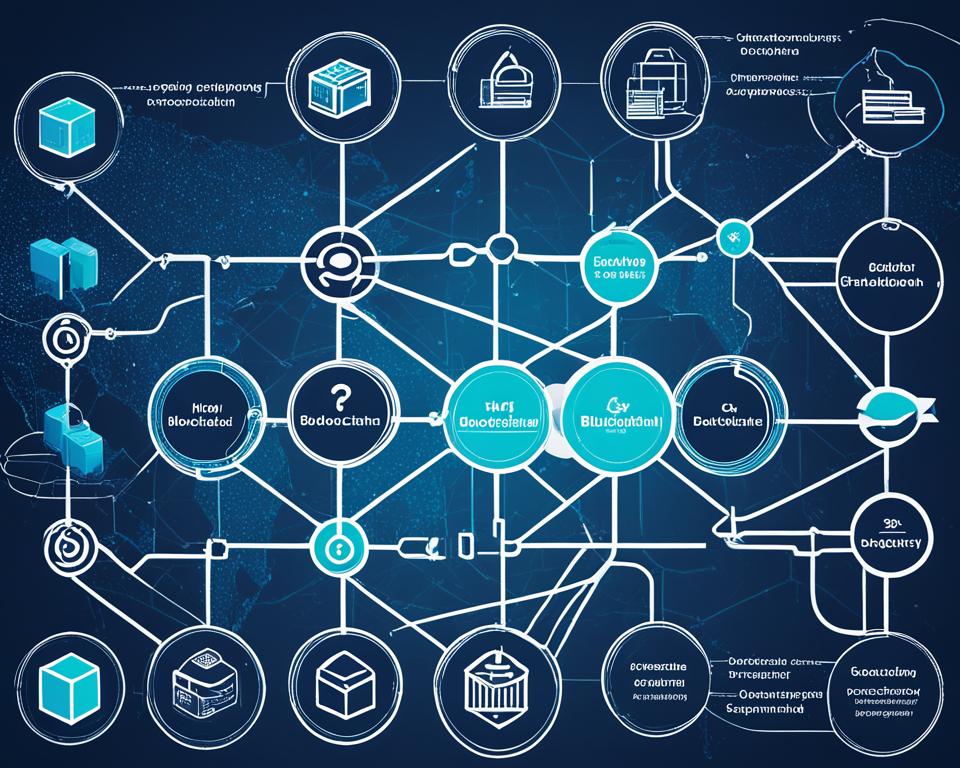In today’s digital world, blockchain technology is changing how we work and interact. It’s making apps that are safe, clear, and new. This guide shows how blockchain can change your business for the better.
It talks about the strength of blockchain, its many uses, and how to make apps with it. You’ll learn how to build apps that can change your field.
Table of Contents
Key Takeaways
- Blockchain technology offers a decentralized and transparent platform for secure data transactions and storage.
- Blockchain app development harnesses the power of this technology to create innovative and disruptive applications.
- Blockchain-based apps can transform industries by enhancing trust, traceability, and efficiency.
- The guide covers the fundamentals of blockchain, its applications, and the step-by-step approach to building blockchain apps.
- Navigating the challenges and considerations is crucial for successful blockchain app development.
Blockchain Technology: A Revolutionary Paradigm
Blockchain technology is changing how we handle data and transactions. It’s a digital ledger that keeps records safely and openly across many computers. This new way of managing data is based on blockchain fundamentals, being decentralized, and transparent.
Understanding the Fundamentals of Blockchain
Blockchain is a decentralized network that doesn’t rely on a single authority. It lists transactions in order, making a record that everyone on the network can see and check. This setup keeps data safe and secure, making it hard to change or fake the information.
Decentralization and Transparency in Action
Blockchain lets people deal with each other directly, cutting out middlemen. This makes transparent transactions easier. Everyone on the network can see and check the transactions, making things more open.
“Blockchain technology has the potential to transform industries by providing a secure, transparent, and decentralized platform for conducting transactions and managing data.”
Decentralization and transparency make blockchain popular. They offer a secure, efficient, and trustworthy way to handle data and make transactions online.
The Power of Blockchain Apps
Blockchain technology is changing many industries. It makes apps secure, clear, and innovative. These apps, called decentralized applications (DApps), use blockchain’s key features. They make sure data is safe, clear, and can’t be changed or censored.
Blockchain apps are changing how we do many things, like finance, supply chain, healthcare, and voting. They’re built on blockchain, which keeps data safe and clear. It also cuts out middlemen.
- In finance, blockchain apps change how we do transactions and manage money. They make things more efficient, secure, and clear.
- In supply chain, these apps make tracking easier and streamline logistics. They also make the whole process more transparent.
- In healthcare, blockchain apps change how patient data is kept and shared. This ensures data safety and privacy while helping healthcare workers work together better.
- In voting, blockchain apps offer secure, clear, and safe ways to vote. This builds trust in our democratic process.
“Blockchain technology has the potential to transform industries by enabling the development of secure, transparent, and innovative solutions.”
These examples show how blockchain apps and decentralized apps are changing things. As blockchain use grows, we’ll see more innovative solutions. These will challenge old ways and lead to a more secure, transparent future.
Applications of Blockchain in Various Industries
Blockchain technology is changing how industries work. In finance, blockchain-based apps are changing banking. They make transactions secure, fast, and easy across borders. They also help manage digital assets and records better.
In the supply chain, blockchain apps make tracking goods easier. They make logistics smoother and increase transparency. This helps businesses manage their inventory better and reduce the risk of fake products.
Blockchain in Finance: Revolutionizing Banking
Blockchain has changed banking for the better. It offers a secure way to handle money transfers. This means faster, cheaper payments across borders.
It also helps manage digital assets and records. This keeps financial data safe and easy to get to everyone.
Blockchain in Supply Chain: Enhancing Traceability
Blockchain is changing how we track goods in the supply chain. It uses blockchain’s secure, unchangeable nature to track items. This helps businesses keep track of their inventory better.
It also helps fight against fake products. And it makes sure companies follow the rules.
| Industry | Blockchain Application | Key Benefits |
|---|---|---|
| Finance | Secure and transparent transactions, cross-border payments, asset management | Increased efficiency, reduced costs, improved data integrity |
| Supply Chain | Traceability of goods, materials, and information | Enhanced inventory management, reduced counterfeiting, improved compliance |
As blockchain technology grows, we’ll see more uses in different industries. This will change how businesses work and what they offer to customers.
“Blockchain technology has the potential to revolutionize industries, from finance to supply chain management, by providing a secure, transparent, and decentralized platform for data exchange and record-keeping.”
Blockchain App Development: A Step-by-Step Guide
Building a blockchain app is a strategic process. It starts with picking the right blockchain platform and designing the app to use this powerful tech. This guide will help you through the key steps in making blockchain apps. It will empower you to make smart choices and create new blockchain solutions.
Selecting the Right Blockchain Platform
Choosing a blockchain platform is a big decision that affects the whole development. Look at things like scalability, transaction speed, consensus mechanisms, and developer support. Platforms like Ethereum, Hyperledger, and Corda have different features and strengths. Make sure your project fits well with the platform’s abilities.
Building the Application Architecture
The application architecture is the base of your blockchain app. It involves designing smart contracts that set the rules and picking the right consensus mechanisms for data integrity. Think about data storage too, which can be on-chain or off-chain, like IPFS or centralized databases.
| Blockchain Platform | Scalability | Transaction Speed | Consensus Mechanism |
|---|---|---|---|
| Ethereum | Moderate | Relatively Slow | Proof of Work (PoW) |
| Hyperledger Fabric | High | Fast | Pluggable Consensus |
| Corda | High | Fast | Raft, BFT |
By picking the right blockchain platforms and designing a strong application architecture, you can tap into the full power of blockchain app development. This way, you can create solutions that change industries and reshape the digital world.
Challenges and Considerations
Blockchain technology has many benefits but also faces challenges. Scalability and performance issues and changing laws are big hurdles for developers. They must tackle these to make blockchain work well.
Scalability and Performance Issues
One big challenge is making blockchain scalable and fast. These networks are secure but can be slow. Developers need to make them faster without losing security.
Regulatory Compliance and Legal Frameworks
Rules around blockchain are always changing. It’s key for apps to follow these rules. Developers must keep up with laws and make sure their apps follow them.
| Challenge | Description |
|---|---|
| Scalability | The ability of the blockchain network to handle increasing transaction volumes and data processing demands without compromising performance or decentralization. |
| Performance | The speed and efficiency at which the blockchain network can process and validate transactions, with the goal of matching or exceeding traditional centralized systems. |
| Regulation | The need to navigate the evolving legal and regulatory landscape surrounding blockchain technology, ensuring compliance with industry-specific laws and data privacy requirements. |
“Addressing the scalability and performance challenges of blockchain technology is crucial for its widespread adoption and success in real-world applications.”
Blockchain App Development: Building the Future
Blockchain technology is changing the game in app development. It lets developers make blockchain apps that are safe, clear, and run by everyone. These apps solve complex problems in many areas with innovative solutions.
The future of blockchain looks bright, with endless chances to change how we live and work. Blockchain app development is leading the charge in tech innovation. It’s changing industries like finance, supply chain, healthcare, and more.
Blockchain apps use distributed ledger tech for safe and clear data handling. They make cross-border deals and peer-to-peer actions easy. Without middlemen, these apps build trust, boost efficiency, and make things easier for everyone.
“Blockchain technology has the potential to fundamentally reshape the way we think about and interact with the digital world. The development of blockchain apps is a crucial step in realizing this potential.”
Blockchain tech has many uses, from DeFi platforms to tracing supply chains. As more people use blockchain app development, we’ll see more new and game-changing apps. These apps will shake up industries and help people in big ways.
The future of blockchain app development is looking good. With this powerful tech, developers can tackle today’s problems and create a better digital tomorrow. It’s all about making things more secure, clear, and fair for everyone.
Security and Privacy in Blockchain Apps
Blockchain technology is growing fast, making it key to keep blockchain apps safe and private. They use cryptographic techniques and consensus mechanisms to secure transactions. This keeps the network safe and honest.
Cryptography and Consensus Mechanisms
Cryptographic protocols are vital for blockchain security. They use complex math to check transactions, keep data safe, and stop unauthorized access. Consensus mechanisms like Proof of Work (PoW) or Proof of Stake (PoS) make sure everyone agrees on transaction validity. This boosts the system’s security.
Data Privacy and User Control
Blockchain gives users more control over their data. It uses blockchain security and a decentralized setup for better data privacy and openness. Users can choose who gets their data, lowering the chance of it being misused.
“Blockchain technology has the potential to revolutionize the way we approach data privacy and security, empowering users to take control of their digital assets.”
As blockchain apps grow, focusing on strong cryptographic solutions and consensus mechanisms is key. This ensures the apps stay secure and private.
The Rise of Decentralized Applications (DApps)
Blockchain technology is changing fast, and decentralized applications (DApps) are leading the way. They challenge old models by not needing a single boss. This means more security, transparency, and control for users.
DApps change how we use digital services. They let users control their data and money. This is making old business models shake up and giving people more power in the digital world.
DApps are entering many areas, like finance and supply chain. They bring new benefits that grab the interest of both companies and users. These apps make things more efficient and transparent, starting a new era of digital experiences focused on the user.
The use of decentralized applications is growing fast. This tech change is set to change how we see and use digital services. The rise of DApps means we’re moving towards a future where people have more control. Blockchain-based apps are pushing the limits of what’s possible online.
| Feature | Traditional Apps | Decentralized Applications (DApps) |
|---|---|---|
| Control | Centralized authority controls data and operations | Users have direct control over their data and transactions |
| Transparency | Limited visibility into backend processes and data | Increased transparency through distributed ledger technology |
| Security | Vulnerable to single point of failure and data breaches | Enhanced security through cryptography and consensus mechanisms |
| Accessibility | Restricted by geographic boundaries and regulatory frameworks | Global accessibility and permissionless participation |
“The rise of decentralized applications is a testament to the transformative power of blockchain technology, empowering users and challenging the status quo across industries.”
The future looks bright for decentralized applications as blockchain grows. This tech change is creating a fairer, clearer, and user-focused digital world. DApps are ready to tackle big challenges and bring about real change.
Conclusion: Embracing the Future of Blockchain
Blockchain technology is changing how we interact and manage data across different industries. It offers secure, transparent, and decentralized ways to do things. This makes it a key player in the future of innovation and empowerment for both people and businesses.
More and more, blockchain technology is being used. It’s time to jump on board and see what it can do for us. This innovative technology opens up new possibilities for building the blockchain future.
Blockchain is changing many industries, making them more secure and giving users more control over their data. It’s making a big impact in finance and supply chain management, and we’re just starting to see what else it can do. Developers, entrepreneurs, and leaders need to keep up with this tech revolution and see the many chances it offers.
By embracing the blockchain future, we aim for a world that’s more secure, open, and decentralized. Trust and working together will lead to more innovation and progress. We have the power to shape the future, and blockchain can help us do just that. It can open new doors, change industries, and make the world more fair and powerful for everyone.














